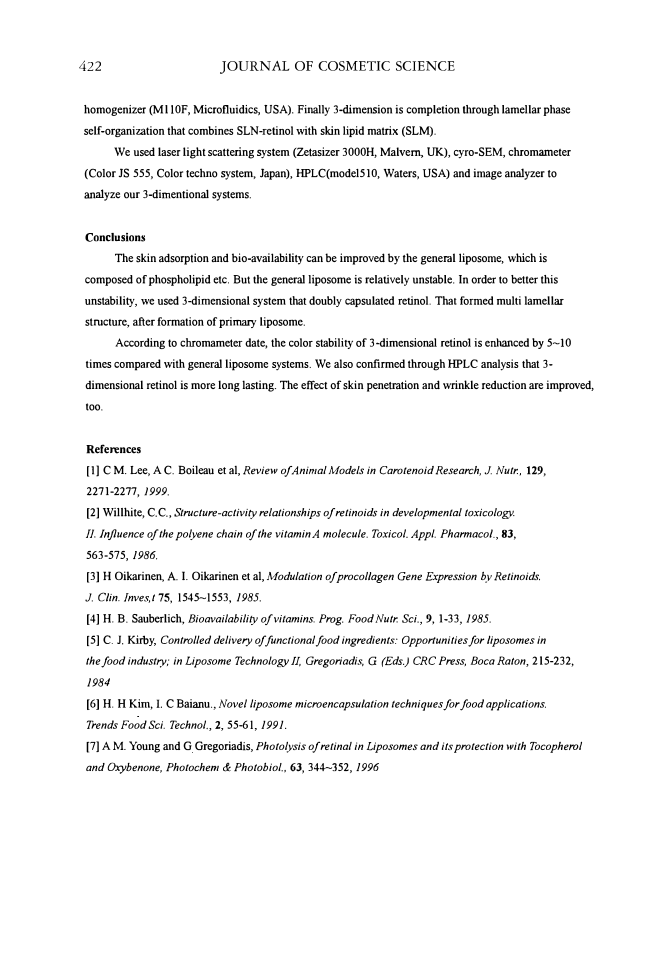2004 ANNUAL SCIENTIFIC SEMINAR 421 THE STUDY FOR RETINOL STABILITY USING 3-DIMENSION Jung Sik Choi and Hong Geun Ji Department of R&D Center, H & A Pharma Chem., Bucheon-si, 421-080, Korea Introduction In these several years, the functional materials have attracted many people being engaged in cosmetics and pharmaceutics because of their infinite application. Retinol is one of those kinds of materials owing to a wide variety of biological functions such as palpating embryonic growth and development, vertebrate vision, immune reactions and epidem1al di:ff erentiation. It is also a prime candidate for cancer prevention. [ 1-3], However its efficaciousness is falling down as time is going by, because vitamin activity is decreased by isomerization, photochemical oxidation and thermal oxidation. Such degradation reactions can also reduce vitanun activity of stored and processed foods. In general, the stability of retinol and its relatives is gently declined in condition of high humidity, low pH and high temperature. [ 4] Retinol is a fat-soluble material and abundant in fish and mammalian liver, milk fat and egg yolks. Due to its hydrophobic character, it is usually found in a complex with lipid droplets or micelles. If this system, liposome, could be applied, we could expect to protect retinol from degradatiYe reactions.[5-6] Liposome is spherical closed vesicles of phospholipid bilayers with an entrapped aqueous phase. The lipid layers are mainly made up phospholipids that are amphophilic. In aqueous solution, they are arranged in bilayers, which form closed vesicles like artificial cells. In the cosmetic area, liposome is used to stabilize the tmstable materials against exterior condition (air, light, oxygen, etc), maximize their efficacy and enhance skin absorption by phospholipid having the great affinity for skin. The stability and delivery of liposome-incorporated retinol has been studied in several articles. However, the stability of retinol in liposome has not been sufficiently studied. [7] Materials and Experimental Materials In this experiment, Retinol 50C (1.58 Million LU.lg, BASF), Lipoid S 100-3 and S 75-3 (Lipoid) are used as received. Other material also are commercial available. Purified water passed tluough an anion cation exchange resin column is employed. Experimental The stability and skin penetration of retinol are improved by 3-dimensional method. As I-dimension, porous silica is prepared using sol-gel method, and then retinol is entrapped into mesoporous silica. As 2- dimension, solid lipid nanoparticles (SLN) containing retinoland silica are obtained by high pressure
422 JOURNAL OF COSMETIC SCIENCE homogenizer (Ml I0F, Microfluidics, USA). Finally 3-dimension is completion through lamellar phase self-organization that combines SLN-retinol with skin lipid matrix (SLM). We used laser light scattering system (Zetasizer 3000H, Malvern, UK), cyro-SEM, chromameter (Color JS 555, Color techno system, Japan), HPLC( model510, Waters, USA) and image analyzer to analyze our 3-dimentional systems. Conclusions The skin adsorption and bio-availability can be improved by the general liposome, which is composed of phospholipid etc. But the general liposome is relatively unstable. In order to better this unstability, we used 3-dimensional system that doubly capsulated retinol. That formed multi lamellar structure, after formation of primary liposome. According to chromameter date, the color stability of 3-dimensional retinol is enhanced by 5~ I 0 times compared with general liposome systems. We also confirmed through HPLC analysis that 3- dimensional retinol is more long lasting. The effect of skin penetration and wrinkle reduction are improved, too. References [l] CM. L ee, AC. Boileau et al, Review of Animal Models in Carotenoid Research, J. Nutr., 129, 2271-2277, 1999. [2] Willhite, C.C. , Structure-activity relationships of retinoids in developmental toxicology. II. Influence of the polyene chain of the vitamin A molecule. Toxicol. Appl. Pharmaco/., 83, 563-575, 1986. [3] H Oikarinen, A I. Oikarinen et al, Modulation of procol/agen Gene Expression by Retinoids. J. C/in. lnves,t 15, 1545~1553, 1985. [4] H.B. Sauberlich, Bioavailability of vitamins. Prag. Food Nutr. Sci., 9, 1-33, 1985. [5] C. J. Kirby, Controlled delivery of functional food ingredients: Opportunities for /iposomes in the food industry in Liposome Technology II, Gregoriadis, G (Eds.) CRC Press, Boca Raton, 215-232, 1984 [6] H. H Kim, I. C Baianu., Novel liposome microencapsu/ation techniques for food applications. Trends Food Sci. Technol., 2, 55-61, 1991. [7] AM. Young and G Gregoriadis, Photolysis of retinal in Liposomes and its protection with Tocopherol and Oxybenone, Photochem & Photobiol., 63, 344~352, 1996
Purchased for the exclusive use of nofirst nolast (unknown) From: SCC Media Library & Resource Center (library.scconline.org)






































































































